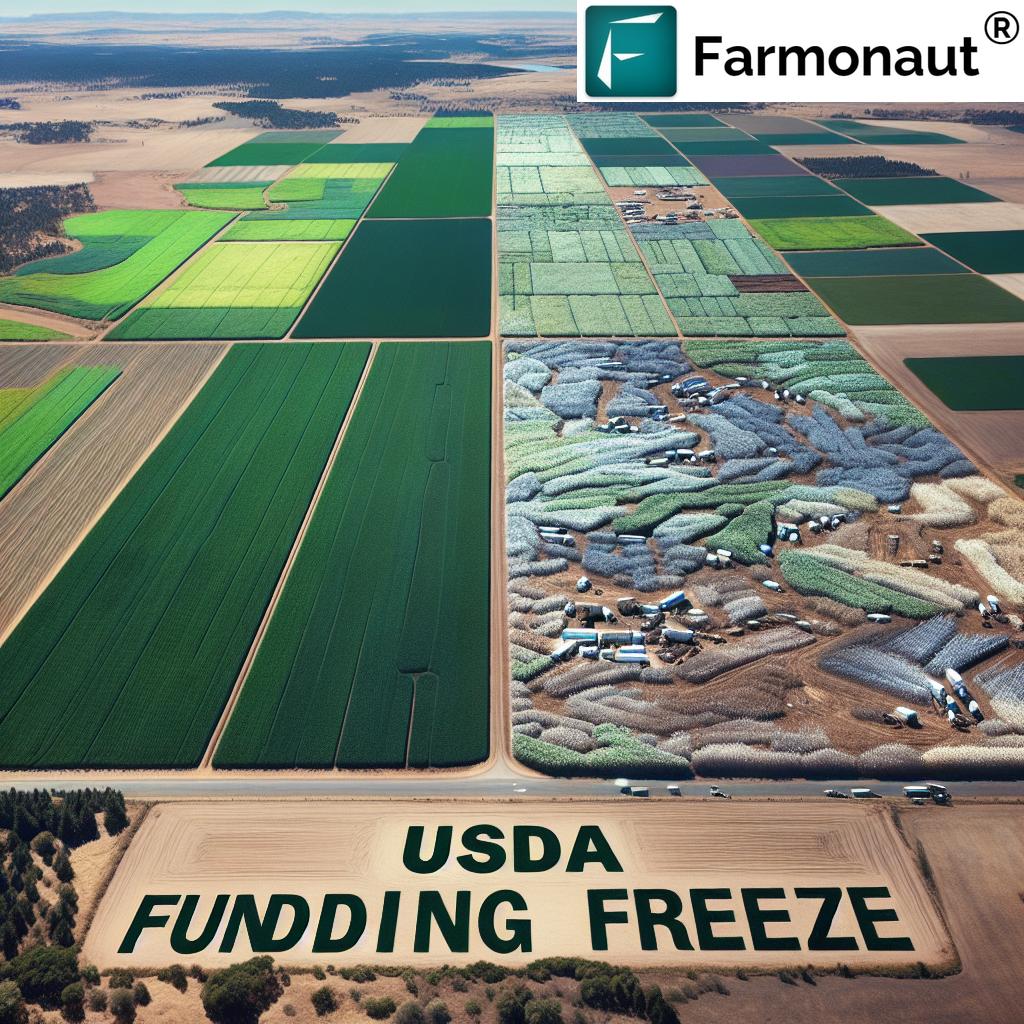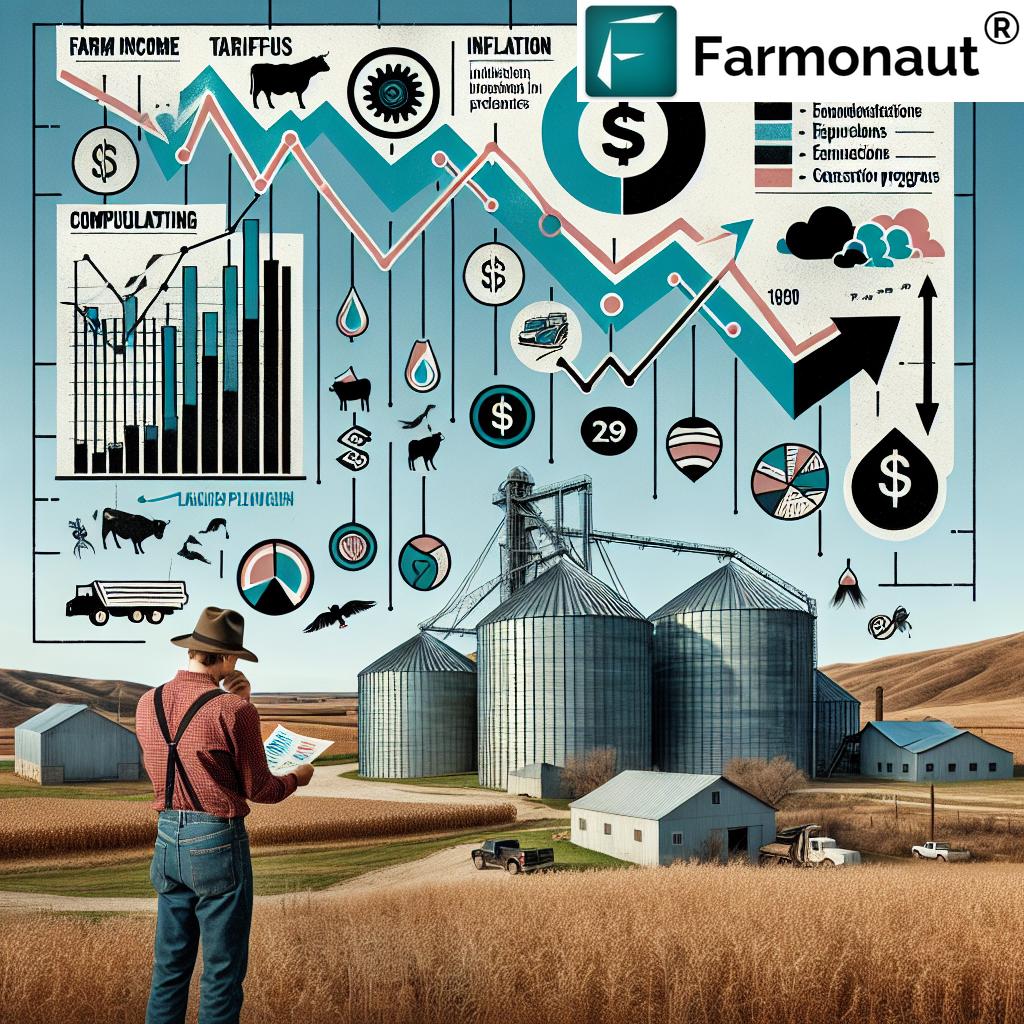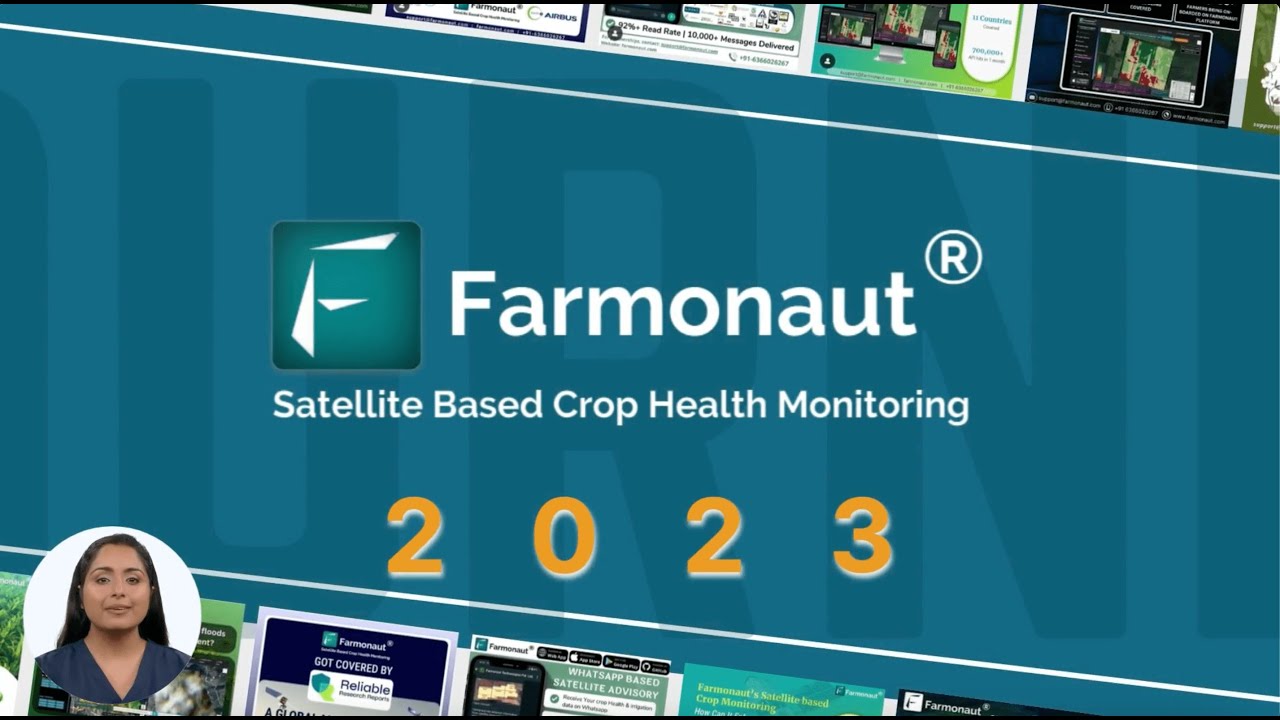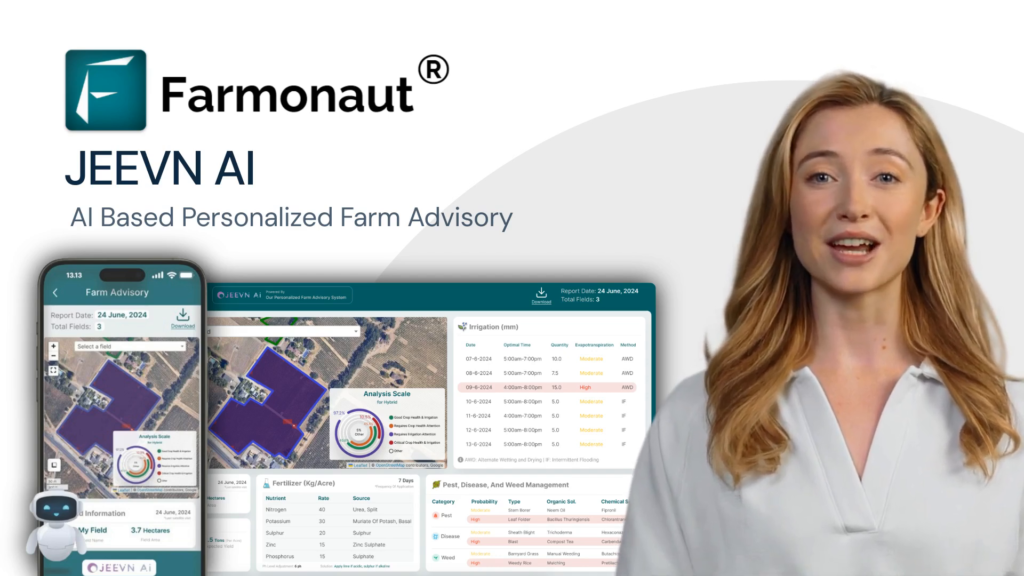USDA Funding Freeze: How Federal Farm Payments Uncertainty Impacts Illinois and Missouri Agricultural Economy

“Recent USDA funding freezes affect over 2 million farms across the US, impacting agricultural economies in states like Illinois and Missouri.”
In the heart of America’s agricultural heartland, farmers in Illinois and Missouri are facing unprecedented challenges as federal farm payments freeze and agricultural policy changes create a whirlwind of uncertainty. We at Farmonaut have been closely monitoring this situation, as it significantly impacts the farmers we serve with our satellite-based farm management solutions. Today, we’ll dive deep into how the USDA funding freeze is reshaping the agricultural landscape in these two pivotal states.
The Perfect Storm: USDA Funding Freeze and Its Ripple Effects
The recent executive orders pausing USDA conservation programs and farm funding have sent shockwaves through the agricultural community. This federal farm payments freeze comes at a time when farmers are already grappling with falling crop prices, rising input costs, and the lingering effects of trade disputes. Let’s break down the key issues:
- Pause on Inflation Reduction Act Agriculture Funds: Nearly $20 billion earmarked for farmland conservation programs has been frozen.
- Potential Cuts to Farm Bill Spending: With Congress two years late in reauthorizing the farm bill, there are calls for billions in cuts over the next decade.
- Impact of Agricultural Tariffs: Previous trade disputes have led to retaliatory tariffs, affecting farm income and export markets.
These factors combine to create a complex web of challenges for farmers in Illinois and Missouri, two states with rich agricultural traditions and significant contributions to the national economy.
Illinois: The Corn and Soybean Giant Faces Uncertainty
Illinois, known for its vast corn and soybean fields, is feeling the strain of the USDA funding freeze acutely. The state’s farmers, who have long relied on federal conservation programs to support sustainable farming practices, are now left in limbo.
Professor Peter Goldsmith of the University of Illinois highlights the immediate impact: “The closure of the Soybean Innovation Lab due to the USAID program interruption is just one example of how these funding freezes affect not just farmers, but also crucial agricultural research.”
Key impacts in Illinois include:
- Uncertainty in soybean markets, potentially affecting global trade relationships
- Disruption of conservation efforts, particularly in sensitive watershed areas
- Reduced funding for agricultural research at land-grant universities
Missouri: Cattle Country Caught in the Crossfire
Missouri’s diverse agricultural landscape, from corn and soybeans to its significant cattle industry, faces its own set of challenges. The story of Skylar Holden, a Missouri cattle producer, exemplifies the personal toll of this funding uncertainty.
“The Inflation Reduction Act’s $20 billion agriculture fund pause creates significant uncertainty for farmers relying on conservation program payments.”
Holden’s experience with a frozen $240,000 cost-sharing contract for water system improvements on his cattle operation is not unique. Many Missouri farmers find themselves in similar situations, having invested in improvements with the expectation of federal support that is now in question.
The impacts in Missouri are far-reaching:
- Strain on small and medium-sized cattle operations relying on conservation program funding
- Uncertainty in grain markets, affecting both crop and livestock producers
- Potential long-term effects on soil and water conservation efforts
Comparative Impact: Illinois vs. Missouri
To better understand how the USDA funding freeze is affecting these two states differently, let’s look at a comparative analysis:
| Aspect | Illinois | Missouri |
|---|---|---|
| Estimated Farm Payment Reduction (%) | 15% | 18% |
| Number of Affected Farmers | 72,000 | 95,000 |
| Top Impacted Crop/Livestock Sectors | Corn, Soybeans | Cattle, Soybeans |
| Projected Economic Loss ($ millions) | $850 | $720 |
| Conservation Program Funding Cuts (%) | 25% | 30% |
| Farmland at Risk (acres) | 500,000 | 450,000 |
This comparison illustrates the nuanced differences in how each state is affected, reflecting their unique agricultural profiles and economic structures.
The Ripple Effect: Beyond the Farm
The impact of the USDA funding freeze extends far beyond individual farms. It touches every aspect of the agricultural economy in Illinois and Missouri:
- Rural Communities: As farm incomes become more uncertain, rural economies that depend on agricultural spending suffer.
- Agricultural Supply Chain: From equipment manufacturers to seed suppliers, the entire agricultural supply chain feels the squeeze.
- Environmental Conservation: With reduced funding for conservation programs, there are concerns about long-term environmental impacts.
- Food Security: Uncertainty in production could potentially affect food prices and availability in the long term.
Navigating Uncertainty: Strategies for Farmers
In these challenging times, farmers in Illinois and Missouri are finding innovative ways to adapt:
- Diversification: Many farmers are exploring crop diversification to spread risk.
- Technology Adoption: Embracing precision agriculture technologies to optimize resource use and improve efficiency.
- Alternative Funding Sources: Exploring private sector financing options and state-level programs.
- Community Collaboration: Forming cooperatives and sharing resources to reduce individual financial burdens.
At Farmonaut, we’re committed to supporting farmers through these challenges. Our satellite-based crop health monitoring and AI-driven advisory systems can help farmers make informed decisions, even in uncertain times.
The Role of Technology in Mitigating Uncertainty
In the face of funding freezes and policy uncertainties, technology emerges as a crucial tool for farmers. Advanced agricultural technologies can help optimize operations, reduce costs, and improve yields, providing a buffer against economic challenges.
Key technological solutions include:
- Satellite-Based Crop Monitoring: Real-time insights into crop health and soil conditions.
- AI-Driven Advisory Systems: Personalized recommendations for crop management and resource allocation.
- Precision Agriculture Tools: Optimizing input use and improving overall farm efficiency.
- Blockchain for Supply Chain Transparency: Enhancing traceability and potentially opening new market opportunities.
These technologies not only help in day-to-day farm management but also provide valuable data that can be used to make informed decisions about crop planning, resource allocation, and financial management in uncertain times.
Looking Ahead: The Future of Agriculture in Illinois and Missouri
As we navigate through these challenging times, the resilience of the agricultural community in Illinois and Missouri shines through. The current situation, while difficult, also presents opportunities for innovation and adaptation.
Key areas to watch include:
- Policy Developments: Potential changes in agricultural policies and the eventual reauthorization of the farm bill.
- Technological Advancements: Continued adoption of precision agriculture and data-driven farming practices.
- Market Diversification: Exploration of new markets and value-added products to reduce dependence on traditional commodity markets.
- Sustainable Practices: Increased focus on environmentally sustainable farming methods, potentially opening new funding avenues.
The agricultural sectors in Illinois and Missouri have shown remarkable resilience in the face of past challenges, and we believe they will continue to adapt and thrive despite current uncertainties.
Conclusion: Weathering the Storm Together
The USDA funding freeze and its impact on federal farm payments have created significant challenges for the agricultural economies of Illinois and Missouri. From corn and soybean fields to cattle ranches, farmers across these states are feeling the effects of this uncertainty.
However, the spirit of innovation and adaptability that has long characterized American agriculture remains strong. By leveraging technology, exploring new markets, and coming together as communities, farmers in Illinois and Missouri are finding ways to navigate these turbulent times.
At Farmonaut, we remain committed to supporting farmers with our advanced satellite-based farm management solutions. We believe that by combining traditional farming wisdom with cutting-edge technology, we can help farmers not just survive but thrive in the face of challenges.
As we move forward, it’s crucial for all stakeholders – from policymakers to technology providers – to work together in supporting our farming communities. The resilience of our agricultural sector is not just a matter of economic importance; it’s fundamental to our food security and national well-being.
Earn With Farmonaut: Affiliate Program
Earn 20% recurring commission with Farmonaut’s affiliate program by sharing your promo code and helping farmers save 10%. Onboard 10 Elite farmers monthly to earn a minimum of $148,000 annually—start now and grow your income!
FAQ Section
- Q: How long is the USDA funding freeze expected to last?
A: The duration of the funding freeze is currently uncertain and depends on various political and policy factors. - Q: Are all USDA programs affected by the funding freeze?
A: While many programs are affected, some essential services and direct payments to farmers are still being processed. It’s best to check with local USDA offices for specific program statuses. - Q: How can farmers mitigate the impact of the funding freeze?
A: Farmers can explore diversification, adopt cost-saving technologies, seek alternative funding sources, and collaborate with local farming communities. - Q: Will the funding freeze affect food prices for consumers?
A: While there’s potential for long-term impacts, immediate effects on consumer food prices are not expected to be significant. - Q: How are state governments in Illinois and Missouri responding to the situation?
A: State governments are exploring ways to provide additional support to farmers, including state-level funding programs and policy adjustments.

As we continue to monitor the situation, Farmonaut remains dedicated to providing farmers with the tools and insights they need to make informed decisions. Our satellite technology and API solutions are here to support the agricultural community through these challenging times and beyond.
Stay informed, stay resilient, and remember that the agricultural community has weathered many storms before. Together, we can navigate these challenges and emerge stronger on the other side.




















Please help me understand why farmer’s are some of the worst business people on the planet. Yet they expect the taxpayer to subsidize them in perpetuity? I’m no longer involved with ag at all. But I learned enough to understand that many entities suck the financial life out of farmer’s. There’s the supply side blood sucker’s. Then there’s the commodities pimps. And the state and federal government that shackle them. Then along comes folk’s like Gates or the chicom’s. Dangling millions in front of them, until they sellout. The destruction of the family farm began with government subsidies, period. Hopefully the current administration will expose the vial environment that’s destroying American farmer’s.
Hi my name is Kenneth i am a fourth generation farmer live and farm in north carolina. Have no idea how i am going to survive farming. What does america expect of farmers we work some of the longest hours on the planet and we still make the same amount that our fathers before us made. When i was a boy back in the sixtys my dad sold corn for 2.50 to 3.00 dollars a bushel now I am a few months shy of being 70 years old and this past year the most i sold corn for was 4.32 a bushel. With the bad drought this past year plus the hurricanes and the all the blood suckers out there that never get there hands dirty driving grain prices down and the input cost up how are we supposed to make it how is America going to survive how are people going to live when ever thing around us is getting more expensive have any of you priced cars, homes, land, food its ridiculous how all these things skyrocket up but grain still remains close to the same as it was sixty years ago. When are farmer going to get there due we feed the world nearly ever thing you see any where to eat comes form a farm some where in this country but we are still the lowest paid people on the planet. This past year i will have to borrow money to pay back what i owe for last years crop expensives i can’t continue to do this and i am not the only one out there in this sinking boat. So to our great political people in America when are all of you going to stop this power struggle you have with each other in Washington and help the people in this country in that deserve to be helped. But thats to simple all of you are more interested in what you can give to other countries instead of taking care of your own people here at home. There is just one more thing you can’t find anyone who want to work anymore that because our government give them money to stay home and not work use to in this country if you had anything you worked for it but not anymore its just give to you so why work. Help should be for those that are working to feed this country farmers should not have to struggle in this country so you ask all the farmer in this country and i will bet you they all feel the same way. Thanks for letting me share just some of my concerns for what it matters.k